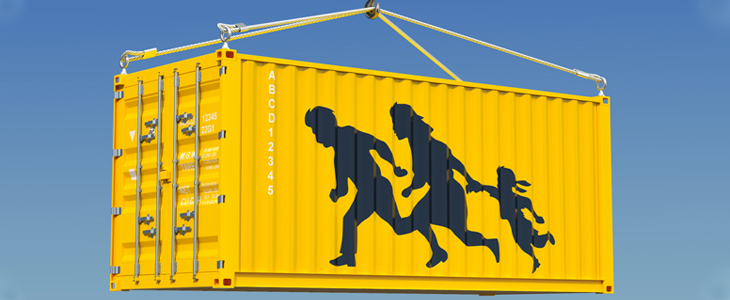
Human trafficking and human smuggling should be defined according to the “United Nations Convention against Transnational Organized Crime and the Protocols Thereto”1 adopted by the General Assembly of The United Nations Office on Drugs and Crime (UNODC) as it is considered to be the first international instrument with agreed definitions on the trafficking of human beings and the smuggling of migrants. In this regard, this article will distinguish human trafficking from human smuggling on the basis of the definitions adopted by the UNODC General Assembly.
Defining Human Trafficking
In Article 3, paragraph (a) of Annex 2 of the “Protocol to Prevent, Suppress and Punish Trafficking in Persons, Especially Women and Children, supplementing the United Nations Convention against Transnational Organized Crime,” human trafficking is defined as follows:
“‘Trafficking in persons’ shall mean the recruitment, transportation, transfer, harbouring or receipt of persons, by means of the threat or use of force or other forms of coercion, of abduction, of fraud, of deception, of the abuse of power or of a position of vulnerability or of the giving or receiving of payments or benefits to achieve the consent of a person having control over another person, for the purpose of exploitation. Exploitation shall include, at a minimum, the exploitation of the prostitution of others or other forms of sexual exploitation, forced labour or services, slavery or practices similar to slavery, servitude or the removal of organs.”2
In addition, it is worth emphasizing that the trafficking of human beings is considered to be a modern form of slavery and a serious crime, mostly organized and transnational in character. It is also a serious violation of human rights and dignity that affects all genders and ages as well as every country worldwide. According to the 2017 “Global Estimates of Modern Slavery” report3 published by the International Labour Organization and the Walk Free Foundation, an estimated 40 million men, women and children were victims of modern slavery in 2016. Nevertheless, it is close to impossible to understand the full scope and scale of the issue due to its hidden nature. As the Belgian Federal Migration Centre (Myria) pointed out in its 2019 annual report,4 the full extent of the trafficking of human beings and the number of victims remains unknown and the data available represents only the tip of the iceberg.
Defining Human Smuggling
In Article 3, paragraph (a) of Annex 3 of the “Protocol against the Smuggling of Migrants by Land, Sea and Air, supplementing the United Nations Convention against Transnational Organized Crime,” human smuggling is defined as follows:
“‘Smuggling of migrants’ shall mean the procurement, in order to obtain, directly or indirectly, a financial or other material benefit, of the illegal entry of a person into a State Party of which the person is not a national or a permanent resident.”5
The Act, the Means and the Purpose
The definition of human trafficking in the “Trafficking in Persons Protocol” identifies three essential elements to consider: the act, the means and the purpose.
The act refers to what is done, which can include recruitment, transfer or transportation, harboring and the receipt of persons.
The means refers to how it is done, which can include the use of force or coercion, deception, fraud, abduction, the abuse of power, the abuse of a position of vulnerability, making payments or providing benefits to obtain the consent of a person, and exercising control over a person.
The purpose refers to why it is done, which can include sexual exploitation, labor exploitation, child sexual exploitation, the removal of organs, offenses committed under coercion and forced begging.
Force, Fraud or Coercion vs. Cooperation and “Complicity”
Human trafficking involves the use of force, fraud or coercion, whether it is real, perceived or implied. Therefore, the individual is considered to be an object of criminal exploitation and the purpose of human trafficking is to exploit victims for economic gain. By contrast, there is no actual, perceived or implied form of coercion in human smuggling, as the individual being smuggled is generally cooperating and complicit in the smuggling crime. Human smuggling often involves criminal commercial transactions between willing parties and occurs with the consent of the individual being smuggled. The latter often pays large sums of money and both parties go their separate ways once they achieve their goal.
It is worth mentioning that the individual being smuggled is not a victim of the smuggling crime. The individual may become a victim depending on the circumstances in which they were smuggled (e.g., exposure to unsafe conditions, physical or sexual violence). Moreover, smuggled individuals may consequently become victims of other crimes. An individual may believe they are being smuggled when they are actually unaware they are being trafficked.
The Movement
Crossing international borders is not required for human trafficking as individuals can be trafficked within the borders of a country. By contrast, human smuggling always involves foreign nationals choosing to immigrate illegally. Smuggling is defined as the illegal migration or harboring of undocumented migrants as it always involves crossing a border illegally or harboring someone who crossed the border illegally.
The Three Stages of Human Trafficking and Human Smuggling
Finally, it is possible to distinguish human trafficking from human smuggling based on the three different stages that constitute both crimes. On the one hand, human trafficking is comprised of recruitment or abduction, transportation and ultimately exploitation of the victim. On the other hand, human smuggling is comprised of solicitation, transportation and payment.
Recruitment/Abduction vs. Solicitation
Recruitment or abduction occurs when victims are obtained through deception or force. According to the Financial Crimes Enforcement Network, “individuals from countries and geographic areas that have been affected by economic hardship, armed conflicts or natural disasters are particularly vulnerable to these tactics.”6 However, solicitation is when migrants seek the services of local facilitators or smugglers who may be part of larger networks working to smuggle migrants across borders. Individuals coming from the types of countries or geographic areas mentioned hereabove are escaping either due to these factors, or on their own initiative.
Transportation
Transportation in human trafficking refers to victims being “transported to locations where they are exploited or sold to other traffickers. Victims may originate from abroad or within the [borders of a country] and may be transported by air, sea and/or land domestically or internationally.”7 By contrast, transportation in human smuggling involves migrants being moved through certain routes and transportation modes to avoid detection. Those being smuggled must originate from abroad.
Exploitation vs. Payment
Exploitation is the final stage of human trafficking. Victims are exploited via sexual assault, forced labor, involuntary participation in crimes or other criminal activity, forced begging or removal of organs. This final stage of human trafficking generates ongoing criminal proceeds in contrast to the one-time criminal proceeds of human smuggling. Payment is the final stage of human smuggling, which may occur in three different forms: payment in advance, partial payment or upon arrival.
- Payment in advance: the full payment is paid prior to departure
- Partial payment: part of the payment is paid prior to departure and the remaining is due upon arrival
- Payment on arrival: the full payment is paid to the smuggler on arrival after the migrant is successfully smuggled
Conclusion
On the basis of the three stages of the human trafficking and human smuggling, the following neatly summarizes the distinction between these two crimes:
- Human trafficking must contain an element of force, fraud or coercion whether it is real, perceived or implied while human smuggling occurs with the consent of the individual being smuggled.
- Human trafficking does not involve the actual movement of the victim and there is no requirement to cross an international border while human smuggling always involves crossing an illegal border or harboring someone who crossed the border illegally.
- Human trafficking generates ongoing criminal proceeds while human smuggling results in one-time criminal proceeds.
Thus, human trafficking is an exploitation-based offense. It is a crime against a person’s fundamental rights. However, human smuggling is transportation-based and involves the deliberate evasion of immigration laws. It is a crime against the government. The former aims at exploiting a person, while the latter may be considered a service.
- “United Nations Convention against Transnational Organized Crime and the Protocols Thereto,” United Nations Office on Drugs and Crime, September 29, 2003, https://www.unodc.org/unodc/en/organized-crime/intro/UNTOC.html
- “Annex II: Protocol to Prevent, Suppress and Punish Trafficking in Persons, Especially Women and Children, supplementing the United Nations Convention against Transnational Organized Crime,” United Nations Office on Drugs and Crime, https://www.unodc.org/documents/middleeastandnorthafrica/human-trafficking/Tip_Protocol_English.pdf
- “Global Estimates of Modern Slavery: Forced Labour and Forced Marriage,” International Labour Organization, September 19, 2017, https://www.ilo.org/global/publications/books/WCMS_575479/lang--en/index.htm
- “2019 Annual report trafficking and smuggling of human beings: Empowering victims,” Myria, https://www.myria.be/en/publications/2019-annual-report-trafficking-and-smuggling-of-human-beings
- “Protocol against the Smuggling of Migrants by Land, Sea and Air,” United Nations Office on Drugs and Crime, https://www.unodc.org/documents/middleeastandnorthafrica/smuggling-migrants/SoM_Protocol_English.pdf
- “Guidance on Recognizing Activity that May be Associated with Human Smuggling and Human Trafficking — Financial Red Flags,” Financial Crimes Enforcement Network, September 11, 2014, https://www.fincen.gov/resources/advisories/fincen-advisory-fin-2014-a008
- Ibid.










